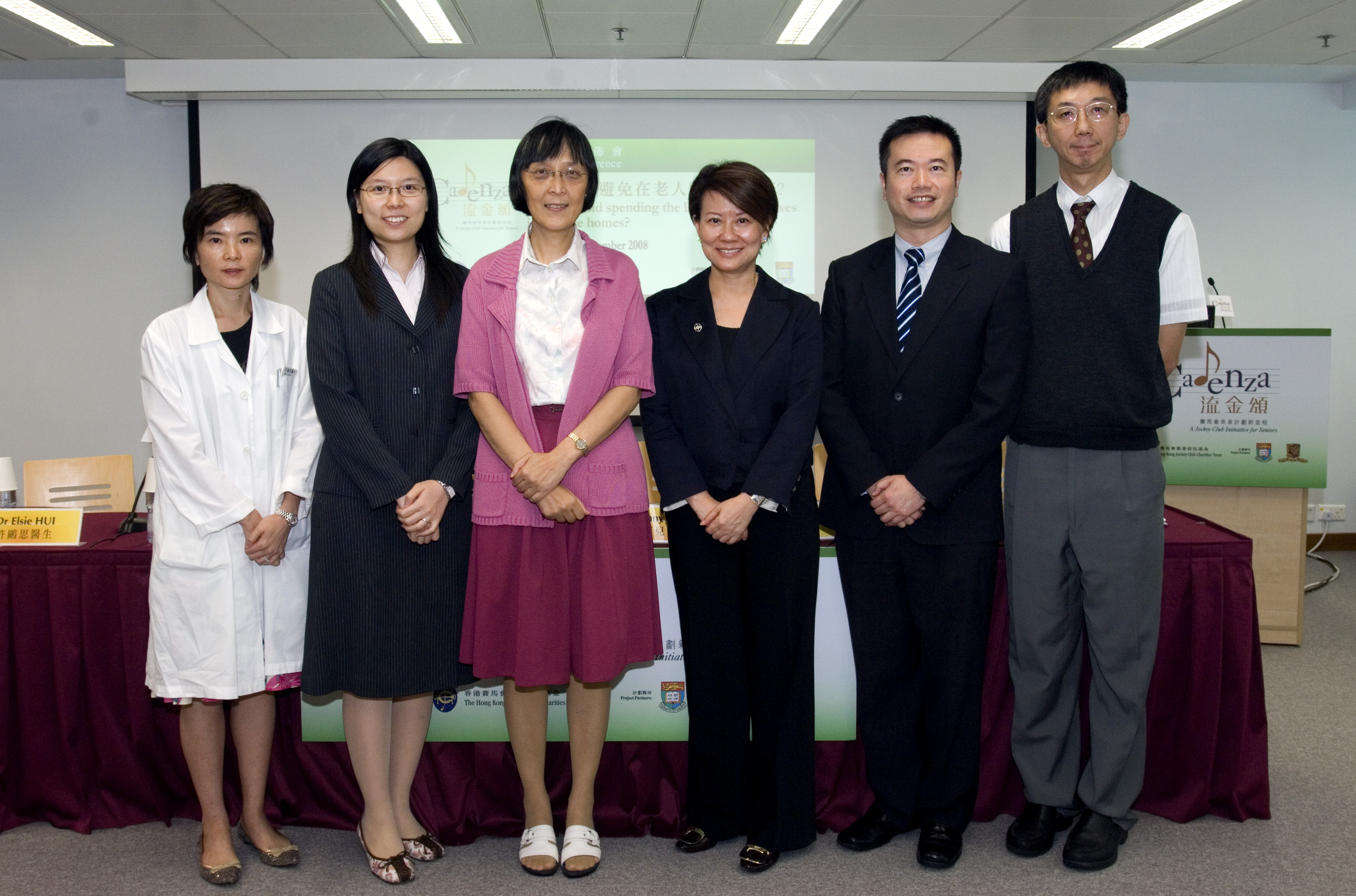CUHK
News Centre
Can we avoid spending the last part of our lives in old age homes?
Elderly with chronic disabling illness such as stroke, chronic lung and heart disease, or dementia living at home depend on family carers. Currently there is a long waiting list for government subvented old age home (OAH) places, although for all types of OAH overall there are vacancies. The total number of places for residential care homes for the elderly in 2008 are 23,969 in the subsidised sector and 48,886 in the private sector. What are the factors from the elder’s and the carer’s perspective predisposing to choice of care in OAH rather than remaining at home? Does knowledge or usage of community services affect this choice?
As part of “CADENZA: A Jockey Club Initiative for Seniors”, a five-year project initiated by The Hong Kong Jockey Club Charities Trust, in collaboration with the Faculty of Medicine of The Chinese University of Hong Kong and the Faculty of Social Sciences of The University of Hong Kong, a survey was conducted to address these questions. From June 2007 to March 2008, 707 elderly people requiring care from others living at home and 705 carers in New Territories East and Hong Kong Island West regions of Hong Kong were successfully interviewed. For the purpose of this study, preference for residential care was defined as having applied OAH or planning to apply OAH in the coming year. Subjects living in residential setting, without any impairment in functional status, or having communication problems were excluded.
Results showed that education level, income and knowledge of community services of the elderly (or the care-recipient) and the carers were not significantly associated with preference for residential care. However, higher age of the elderly or the carer, and care-recipient being a male were significantly associated with greater preference for residential care. In addition, from the elder’s perspective, those with impaired functional status, depression, and more usage of community services were found to have greater preference for residential care. From the carer’s perspective, those with greater carer burden, or whose care-recipients with impaired functional status, dementia, and more usage of community services, were found to have greater preference for residential care.
Community care could be further strengthened by placing it in the context of an integrated primary care model for the elderly, underpinned by comprehensive geriatric assessment followed by individualized case management covering physical, psychological, functional and social needs. However, these initiatives may or may not affect the magnitude of demand for OAH places. Long term residential care placement needs are projected to increase if there is an increase in disability and chronic disease prevalence together with declining mortality rate in our aging population.
Recommendations
1. The structure and staffing of new OAH should be designed to cater for the more dependent residents.
2. Development of a primary care model orientated to the needs of elderly people with multiple physical and/or psychological problems based in community centres may address these needs in the following ways:
‧Geriatricians can play an important role in providing comprehensive geriatric assessment as a basis for case management, to ensure optimization of physical and cognitive function.
‧Evidence-based supportive community services for dementia that would retard decline or facilitate the caring process could be developed and carried out at such centres.
‧Psychosocial support could also be provided at such centres.
‧Carer burden could be reduced by psychosocial interventions, such as educational and supportive groups.
‧Such a model is being developed as part of the CADENZA project.
About CADENZA: A Jockey Club Initiative for Seniors
CADENZA: A Jockey Club Initiative for Seniors, is a $380 million and 5-year project initiated and funded by The Hong Kong Jockey Club Charities Trust, in light of a rapidly ageing population.. Faculty of Social Sciences, The University of Hong Kong and Faculty of Medicine, The Chinese University of Hong Kong are the project partners. It aims at creating an elder friendly community which fosters positive community attitude towards older people and continuously improves the quality of care and quality of life for Hong Kong’s elderly.
CADENZA is an acronym for “Celebrate their Accomplishments: Discover their Efferverscence and Never-ending Zest as they Age.” In classical music, a 'Cadenza' is an extended virtuosic section, usually near the end of a movement in a concerto. The word is used here in a figurative context to describe the apex of one's life and the celebration of a lifetime's accomplishments.
CADENZA has 6 major project components:
1. Community Projectsare innovative and sustainable service models to cope with changing needs of seniors.
2. Research Training Workshop is to nurture academic leadership in social gerontology.
Researchis to advance gerontological knowledge and to evaluate the outcomes of different CADENZA projects.
3. Public Awareness seeks to promote positive ageing and highlight important issues pertaining to elderly population, covering 6 major themes: (i) health promotion and maintenance, (ii) health and social services in Hong Kong, (iii) living environment, (iv) financial and legal issues, (v) quality of life and quality of dying, and (vi) age disparities.
4. Symposium is to provide a platform where the overseas and local experts can exchange new insights in the understanding of aging issues.
5. Training includes on-line courses, workshops and public seminars to train different levels of professional front-line workers, care givers and the general public.
Website: http://www.cadenza.hk
From left: Dr Elsie Hui, Senior Medical Officer, Medical & Geriatric Unit, Shatin Hospital Dr Patsy Pui Hing Chau, Research Assistant Professor of CADENZA Project Professor Jean Woo, Professor of Medicine, Head of Division of Geriatrics, Department of Medicine & Therapeutics, CUHK, Director of CADENZA Project Ms Bonny Wong, Head of Charities, The Hong Kong Jockey Club Dr Felix Hon Wai Chan, Consultant Physician (Geriatrics) TWGHs Fung Yiu King Hospital, President of the Hong Kong Geriatrics Society Professor Timothy Kwok, Professor, Department of Medicine & Therapeutics, CUHK





